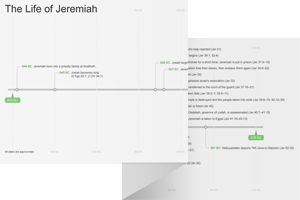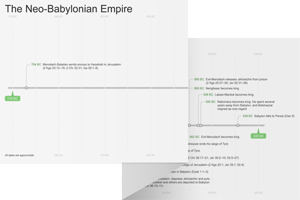25:1–14 This passage summarizes the main themes of Jeremiah’s preaching up to this point: Judah’s idolatry, the coming judgment, Babylonian exile, and judgment on other foreign nations. The basis for an expected 70-year exile is found in v. 11. |
25:1 the fourth year of Jehoiakim 605 bc. See note on 22:18.
the first year of Nebuchadnezzar Likely a reference to the accession year of Nebuchadnezzar, which also was 605 bc. See note on Ezek 24:1.
25:3 From the thirteenth year of Josiah, the son of Amon, the king of Judah, even up to this day, these twenty-three years 627–605 bc. See note on Jer 1:2.
25:4 all his servants the prophets Judah has a long history of ignoring God’s messengers, as the nation rejected Jeremiah and all the prophets who came before him. Compare 2 Kgs 17:13–14.
25:5 Turn back The call for Judah to repent is a central part of Jeremiah’s prophecies (see Jer 3:1–4:4).
 The Significance of “Shuv” in Jeremiah
The Significance of “Shuv” in Jeremiah
live on the land Continued possession of the land was conditional on their repentance and obedience (see Deut 8:1 and note).
25:6 you must not go after other gods Loyalty to Yahweh was closely connected to possession of the land (see Deut 30:17 and note).
25:9 all the clans of the north Alludes to the enemy from the north (see Jer 1:15 and note).
Nebuchadnezzar the king of Babylon, my servant Explicitly identifies the enemy from the north as the invading Babylonians. The reference to Nebuchadnezzar as Yahweh’s servant identifies him as the agent of judgment (see note on 21:2). Compare Isa 10:5; 44:28–45:1.
25:10 the sound of jubilation Most of the imagery here echoes Jer 7:34.
the sound of the millstones Used to grind grain into flour. All normal daily activity will cease.
25:11 seventy years A symbolic number, possibly representing a single lifetime (see Psa 90:10 and note; Isa 23:15). The period from 605–539 bc was 66 years. The first return from exile was sometime between 539 and 535 bc.
possibly representing a single lifetime (see Psa 90:10 and note; Isa 23:15). The period from 605–539 bc was 66 years. The first return from exile was sometime between 539 and 535 bc.
25:13 everything that is written in this scroll Jeremiah delivers a lengthy oracle of judgment against Babylon in Jer 50–51. In the Septuagint version, ch. 25 introduces the series of oracles against foreign nations found in chs. 46–51.
25:15–38 An oracle of judgment depicting Yahweh’s wrath as a cup of wine. Jeremiah is to take the cup to the nations. The first half of the oracle is a prose narrative listing the nations to be judged (vv. 15–29). The second half is a poetic description of Yahweh’s judgment on the earth (vv. 30–38). |
25:15 this cup of the wine of wrath A cup of wine as a metaphor for divine punishment appears several times in the ot (see Isa 51:17; Psa 75:8; Jer 49:12; Hab 2:15–16). Isaiah’s use of the image shows that the cup results in drunkenness and loss of physical and mental awareness, not death.
all the nations This cup of wrath is to be distributed to all the nations, not just Israel. The imagery of judgment against foreign nations is more prominent in Jer 46–51.
25:18 Jerusalem and the towns of Judah The judgment starts with Jerusalem and Judah, then spreads out to all the nations.
25:19 Pharaoh, the king of Egypt The list includes all the traditional enemies of Israel and Judah. Pharaoh’s interference in the affairs of Judah likely warranted his being mentioned first. See note on 21:1.
25:20 the land of Uz The exact location of Uz is unknown. It is referenced as the homeland of Job in Job 1:1. It also is mentioned in parallel with Edom in Lam 4:21, which suggests Uz is located south or southeast of the Dead Sea, in the northwest corner of the Arabian Peninsula.
the Philistines Israel’s enemy on the coastal plain west of Judah (see Gen 21:32 and note; Josh 13:3 and note). Their civilization was concentrated in five main cities—Ashkelon, Gaza, Ekron, Ashdod, and Gath.
on the coastal plain west of Judah (see Gen 21:32 and note; Josh 13:3 and note). Their civilization was concentrated in five main cities—Ashkelon, Gaza, Ekron, Ashdod, and Gath.
25:21 Edom Judgment started with Judah and gradually spiraled outward. The first nations mentioned are Israel’s closest neighbors and oldest enemies. Edom was Judah’s neighbor to the southeast on the southeastern corner of the Dead Sea. The Edomites were descendants of Jacob’s brother, Esau (see note on Gen 25:25).
Moab Judah’s neighbor east of the Jordan River. The Moabites were descended from Abraham’s nephew, Lot (see Gen 19:30–38).
the Ammonites Judah and Israel’s neighbor east of the Jordan and north of Moab. The Ammonites were also descended from Lot (see Gen 19:30–38).
25:22 Tyre The leading city of the Phoenicians (see note on Ezek 26:1–28:19). It was located on the Mediterranean coast northwest of Israel (see note on Ezek 26:2).
Sidon An important Phoenician city about 25 miles north of Tyre on the coast.
the coastland that is across the sea Likely refers to Phoenician colonies around the Mediterranean coast.
25:23 Dedan A trading center in north central Arabia. See note on Ezek 27:15.
Tema An Arabian oasis (see note on Isa 21:14).
Buz This location is unknown. It likely refers to another Arabian tribe or settlement.
25:25 Zimri An unknown location. It is paralleled with references in Persia, east of Babylon.
Elam A mountainous region east of Babylon and north of the Persian Gulf (see note on Ezek 32:24). Elam is in the southern area of the Iranian plateau in the Zagros Mountains.
Media The northwest area of the Zagros Mountains and Iranian Plateau, roughly corresponding to the northwest region of modern Iran.
25:26 all the kingdoms of the world Yahweh’s cup of wrath is extended to all the nations of the earth. Jeremiah’s role in symbolically bringing this cup of wrath to the nations fulfills his commission as a “prophet to the nations” (Jer 1:5).
the king of Sheshach The list ends with Judah’s current enemy. Following the Hebrew text, many English translations refer to Babylon as Sheshach (Sheshak), which is an athbash cryptogram (also used in 51:41).
25:30 Yahweh will roar from on high A poetic expression of Yahweh’s appearing in judgment (compare Joel 3:16; Amos 1:2).

|
About Faithlife Study BibleFaithlife Study Bible (FSB) is your guide to the ancient world of the Old and New Testaments, with study notes and articles that draw from a wide range of academic research. FSB helps you learn how to think about interpretation methods and issues so that you can gain a deeper understanding of the text. |
| Copyright |
Copyright 2012 Logos Bible Software. |
| Support Info | fsb |
 Loading…
Loading…



